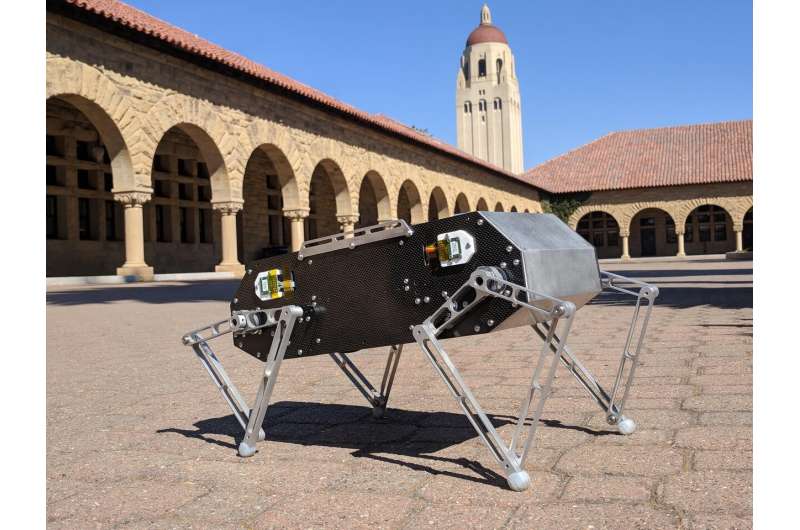May 28, 2019 feature
Stanford Doggo: a highly agile quadruped robot

Researchers at Stanford University have recently created an open-source quadruped robot called Stanford Doggo. Their robot, presented in a paper pre-published on arXiv and set to be published by IEEE Explore, exceeds the performance of many state-of-the-art legged robots in vertical jumping agility.
"About a year and a half ago, I started the Extreme Mobility sub-team at Stanford Student Robotics," Nathan Kau, one of the researchers who carried out the study, told TechXplore. "We were interested in building agile robots that could explore environments where wheeled or flying vehicles wouldn't be effective. A few really amazing robots that can work in these types of environments already exist, but they were quite expensive, custom designs that we wouldn't be able to replicate. So last year, we set out to design and prototype an inexpensive four-legged robot inspired by these groups, and Stanford Doggo is the result of our efforts."
The robot developed by Kau and his colleagues has four legs, each of which is powered by two motors. Belt drives connect the motors to the axles of the leg linkages, which makes the links rotate at one-third of the motors' speed. This speed reduction nearly triples the torque, and the ratio is low enough to ensure that forces from the environment are sensed by the motor.
"This effect is similar to riding a bike at a low gear, and it's easier to feel bumps in the road in your feet than it is at a high gear," Kau explained. "These kinds of mechanisms, called quasi-direct drive actuators, are somewhat common now in legged robots. However, we found that few if any groups were using this type of actuator on smaller, low-cost walking robots."
Stanford Doggo is a highly agile and inexpensive robot that can be easily replicated. Remarkably, the robot has set a new record for vertical jumping agility among any robot or animal, doubling the jump height of previous quadruped robots. Stanford Doggo is also far cheaper than other legged robots, which typically cost tens or hundreds of thousands of dollars.
"In total, Stanford Doggo costs about $3000 USD to build, including all the manufacturing costs you'd incur if you don't have expensive machine tools such as mills or lathes," Kau said. "The low cost means that the robot is more accessible to others, especially if they are not in a university lab. Its most important feature, however, is that it runs on open-source hardware and software and that we've released detailed plans, part lists and instructions."
In a series of evaluations carried out by Kau and his colleagues, Stanford outperformed other quadruped robots by a significant margin. Its vertical jumping agility, a measure of average vertical speed, matched that of the most agile animal and surpassed that of the best performing legged robot by 22 percent. Several other interesting robots are currently being developed, so soon Stanford Doggo's titles might change. Nonetheless, its vertical jumping agility remains highly remarkable.
"We hope that more and more labs will be able to test new control techniques using our robot as a platform," Kau said. "We think that if more people are working on these types of robots, they will become ready more quickly for real world applications such as delivery of critical supplies or search and rescue. We also hope that our robot will inspire students to start exploring the field of legged robotics. It's generally an expensive area of robotics to work in, so we hope Stanford Doggo will lower the barrier to entry."
Kau and his colleagues have succeeded in developing the very first inexpensive and highly agile quadruped robot designed for research applications. Stanford Doggo is entirely open-source and is built using very few custom parts, thus it can be easily recreated. The researchers hope that other robotics teams will build on and improve their robot, progressing their research further.
Kau and his colleagues are also working on a bigger version of Stanford Doggo, called Stanford Woofer. Stanford Woofer is about twice the size of Doggo and can carry about 6kg of additional equipment, such as sensors and a robotic arm.
"Stanford Doggo is still very much an on-going project," Kau added. "For example, we are working on incorporating a full suite of sensors onto the robot including LIDAR. Another sub-project is making the robot look a little less bare and more approachable, especially since we think this could be an effective platform for education and outreach. We are also writing a comprehensive Instructable to supplement our existing open source materials, which gives step-by-step instructions on how to build your own Stanford Doggo."
More information: Stanford Doggo: an open-source, quasi-direct-drive quadruped. arXiv:1905.04254 [cs.RO]. arxiv.org/abs/1905.04254
© 2019 Science X Network



















